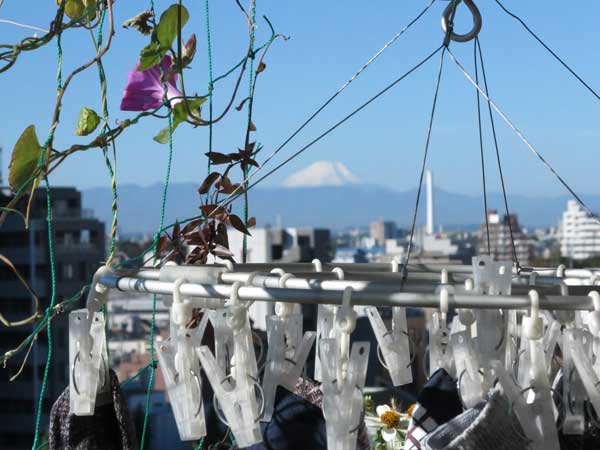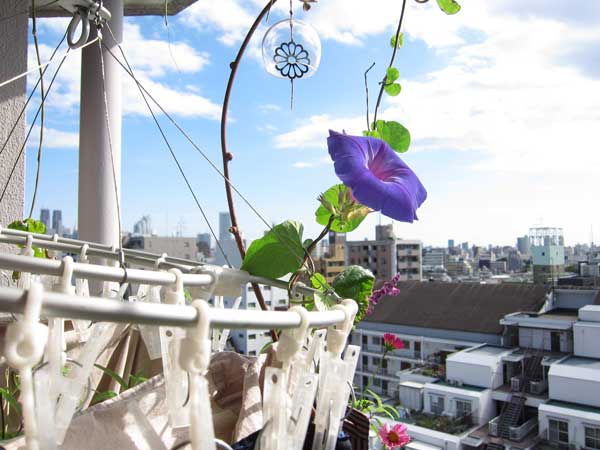
この剪定した松のために、屋根を作り替えたようです。以前、コンクリート製の似たものを見たことがあります。
This is the domestic version of what I saw at a Waseda cafe: poured concrete roof with cut-outs for trunks.

この剪定した松のために、屋根を作り替えたようです。以前、コンクリート製の似たものを見たことがあります。
This is the domestic version of what I saw at a Waseda cafe: poured concrete roof with cut-outs for trunks.

江戸時代から、富士山と都市は一緒にイメージされています。最近、富士山の噴火に関する記事が多いですね。
Recently, there have been several reports that Mount Fuji may erupt and cause an earthquake, or vice versa. What I love about this giant volcano is its utterly domestic and urban nature. Today’s urban views, completely with laundry drying, are an extension of hundreds of years of Edo visual representation.




風鈴がホームレスの家を飾っています。宮下公園の下、渋谷スランブルの近くにあって、この家はとても整然としています。東京はいつも何かと隣り合わせになっていて、垂直な層になっています。例えば、半分公共の空間と空っぽの空間、デザインされた空間とデザインのない空間、住宅、スケードポード場、飲み屋、そしてバイクの駐車場。
A furin is a glass wind chime whose sound Japanese find cooling in summer; something about glass and metal striking. I was amazed to see this domestic symbol, along with a white chandelier (below), decorating two homes in this long row of wood and blue tarp cubes sheltering the homeless. (The furin is just to the right of the rolled up bamboo used to screen door).
I am struck by how incredibly orderly these living structures are, and how on a warm day when you gaze inside, the homes seem orderly and common place: tidy kitchens, matt floors, shelves and storage, on a scale just slightly smaller than what most Tokyo-ites live in.
This long alley of make-shift homes is just below Miyashita Park that paces the Yamanote line for a fe blocks. It’s just past Nonbei Yokocho and near the center of Shibuya. There was controversy over gentrification and corporate funding for city resources when the city accepted Nike sponsorship to renovate the park with design by Atelier Bow Wow. It seems the homeless merely migrated to the area just below the fenced-in skate park and fusball court.
Now it is a typically Tokyo close juxtaposition of semi-public and vacant space, design and non-design, and living, sports, drinking, and parking spaces.


A huge advantage of our small apartment is that both the kitchen and the living face the balcony garden. I love how this ficus vine has crossed the line between outdoor and domestic space.

I recently read Azby Brown’s book, Just Enough: Lessons in Living Green from Traditional Japan. Brown is an architect, professor, author, and expert on Japanese traditional and contemporary building design. This new book explores ecological principles of late Edo Japanese life (about 1800) and their relevance to sustainable living today.
The book mixes three levels of information: detailed descriptions of rural and urban life focused on farmers, carpenters and samurai; hundreds of amazing drawings of ecosystems, houses, tools and objects of everyday life; and finally reflections on how modern society might emulate a zero waste society that fed a population of 30 million including over a million living in Tokyo. By focusing on social structure, farming, transportation, forest management, urban planning, and domestic life, Brown explores how Japan was able to maintain the environment, including clean water, and avoid many of the diseases that plagued European cities of that time.
Brown provides a remarkable analysis of how natural resources were used by this growing population without harming the environment. Some notable examples include limiting forest extraction to fallen limbs and what can be carried on a person’s back, an irrigation system in which the resulting water was filtered and cleaned by rice fields, a transportation system that relied on human and water transport rather than animals, the role of courtyards as shared space for commoners, and samurais’ reliance on urban farms to make ends meet.

Viewed from today’s post-industrial times, it is remarkable to think that Edo Tokyo has a huge tree canopy and significant urban farming, and that zero waste included re-using night soil as fertilizer with a higher price for those of daimyo lords and for entertainers whose diets were richest. By carefully showing how Edo people lived, Brown is able to show how architectural elements like the endogawa porch can be used today as a way of connecting interior and exterior, residents and visitors. Modular and multi-purpose rooms are other features that would make living today both more efficient and comfortable.

My only criticism is Brown’s focus on the ethics of sustainability. I believe that pleasure and ecology must go together, so that making better choices is about improving life not about “doing good,” which is often a poor motivator. Brown does mention some of the coercive features of Edo life that would not be attractive today, such as infanticide as a population control method. For our times, I think the challenge is to both persuade people to embrace zero waste as a lifestyle improvement, and at the same time enact new policies that reflect the true costs of agro-industrial “cheap” food and fossil fuel reliance built.
Current policies promote bad choices, including subsidizing corn sugar despite the health consequences, and hiding the true cost of fuel by externalizing the endless wars that guarantee our supplies, the free roads that encourage sprawl, and the pollution and climate change caused by emissions.
Brown’s book Just Enough will be thought-provoking for those interested in Japanese history and culture, and those engaged in a new global dialogue about a sustainable post-industrial future. His research, analysis and images provide new inspiration for a revitalized relationship between farms and cities, people and nature.

This is a close-up of a small tree that has survived the disintegration of its styrofoam planter box and rooted itself into the ground. It is amazing that it was able to force its way through the pavement and reach the soil.
This potted tree breaking the pavement to root itself in the ground is almost the opposite of the cana flower spreading under and breaking the road to reach the air above. I find these images hopeful signs that no matter how much we pave over nature or confine it to a pot, plants are resilient, resourceful and able to confound our built environment.

By rooting itself in the ground below the street, the tree is able to draw more nourishment and grow larger. I wish that governments and residents would begin to de-pave Tokyo, and it’s great to see that domestic plants are not waiting for us to act.